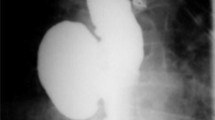Abstract
Purpose
The purpose of this study is to characterize the esophageal motor and lower esophageal sphincter (LES) abnormalities associated with epiphrenic esophageal diverticula and analyze outcomes for laparoscopic esophageal diverticulectomy, myotomy, and partial fundoplication.
Methods
The endoscopic, radiographic, manometric, and perioperative records for patients undergoing laparoscopic esophageal diverticulectomy, anterior esophageal myotomy, and partial fundoplication from 8/99 until 9/06 were reviewed from an Institutional Review Board (IRB)-approved outcomes database. Data are given as mean ± standard deviation (SD).
Results
An esophageal body motor disorder and/or LES abnormalities were present in 11 patients with epiphrenic diverticula; three patients were characterized as achalasia, one had vigorous achalasia, two had diffuse esophageal spasm, and five had a nonspecific motor disorder. Presenting symptoms included dysphagia (13/13), regurgitation (7/13), and chest pain (4/13). Three patients had previous Botox injections and three patients had esophageal dilatations. Laparoscopic epiphrenic diverticulectomy with an anterior esophageal myotomy was completed in 13 patients (M:F; 3:10) with a mean age of 67.6 ± 4.2 years, body mass index (BMI) of 28.1 ± 1.9 kg/m2 and American Society of Anesthesiologists (ASA) 2.2 ± 0.1. Partial fundoplication was performed in 12/13 patients (Dor, n = 2; Toupet, n = 10). Four patients had a type I and one patient had a type III hiatal hernia requiring repair. Mean operative time was 210 ± 15.1 min and mean length of stay (LOS) was 2.8 ± 0.4 days. Two grade II or higher complications occurred, including one patient who was readmitted on postoperative day 4 with a leak requiring a thoracotomy. After a mean follow-up of 13.6 ± 3.0 months (range 3–36 months), two patients complained of mild solid food dysphagia and one patient required proton pump inhibitor (PPI) for gastroesophageal reflux disease (GERD) symptoms.
Conclusion
The majority of patients with epiphrenic esophageal diverticula have esophageal body motor disorders and/or LES abnormalities. Laparoscopic esophageal diverticulectomy and anterior esophageal myotomy with partial fundoplication is an appropriate alternative with acceptable short-term outcomes in symptomatic patients.
Similar content being viewed by others
References
Fasano NC, Levine MS, Rubisen SE, Redfern RO, Laufer I (2003) Epiphrenic diverticulum: clinical and radiographic findings in 27 patients. Dysphagia 18:9–15
Thomas ML, Anthony AA, Fosh BG, Finch JG, Maddern GJ (2001) Oesophageal diverticula. Br J Surg 88:629–642
Tedesco P, Fisichella PM, Way LW, Patti MG (2005) Cause and treatment of epiphrenic diverticula. Am J Surg 190:891–894
Reznik SI, Rice TW, Murthy SC, Mason DP, Apperson-Hansen C, Blackstone EH (2007) Assessment of a pathophysiology-directed treatment for symptomatic epiphrenic diverticulum. Dis Esophagus 20:320–327
Nehra D, Lord RV, DeMeester TR, Theisen J, MD, Peters JH, Crookes PF, MD, Bremner CG (2002) Physiologic basis for the treatment of epiphrenic diverticulum. Ann Surg 3:346–354
Matthews BD, Nelms CD, Lohr CE, Harold KL, Kercher KW, Heniford BT (2003) Minimally invasive management of epiphrenic esophageal diverticula. Am Surg 69:465–470
Dindo D, Demartines N, Clavien PA (2004) Classification of surgical complications: a new proposal with evaluation in a cohort of 6336 patients and results of a survery. Ann Surg 240:205–213
Fekete F, Vonns C (1992) Surgical management of esophageal thoracic diverticula. Hepato-Gastroenterology 39:97–99
Effler DB, Barr D, Groves LK (1959) Epiphrenic diverticulum of the esophagus: surgical treatment. Arch Surg 79:459–467
Belsey R (1966) Functional disease of the esophagus. J Thorac Cardiovasc Surg 52:164–188
Streitz JM, Glick ME, Ellis H (1992) Selective use of myotomy for treatment of epiphrenic diverticula. Manometric and clinical analysis. Arch Surg 127:585–588
Benacci JC, Deschamps C, Trastek VF, Allen MS, Daly RC, Pairolero PC (1993) Epiphrenic diverticulum: results of surgical treatment. Ann Thorac Surg 55:1067–1068
Altorki NK, Sunagawa M, Skinner DB (1993) Thoracic esophageal diverticula. Why is operation necessary? J Thorac Cardiovasc Surg 105:260–264
Rosati R, Fumagalli U, Bona S, Zago M (2001) Laparoscopic treatment of epiphrenic diverticula. J Laparoendosc Adv Surg Tech 11:371–375
Del Genio A, Rossetti G, Maffetton V, Renzi A, Brusciano L, Limongelli P, Cuttitta D, Russo G, Del Genio G (2004) Laparoscopic approach in the treatment of epiphrenic diverticula: long-term results. Surg Endosc 18:741–745
Klaus A, Hinder RA, Swain J, Achem SR (2003) Management of epiphrenic diverticula. J Gastrointest Surg 7:906–911
Fernando HC, Luketich JD, MD, Samphire J, Alvelo-Rivera M, ChristieNA, Buenaventura PO, Landreneau RJ (2005) Minimally invasive operation for esophageal diverticula. Ann Thorac Surg 80:2076–2081
Varghese TK, Marshall B, Chang AC, Pickens A, Lau CL, Orringer MB (2007) Surgical treatment of epiphrenic diverticula: a 30-Year Experience. Ann Thorac Surg 84:1801–1809
Author information
Authors and Affiliations
Corresponding author
Rights and permissions
About this article
Cite this article
Melman, L., Quinlan, J., Robertson, B. et al. Esophageal manometric characteristics and outcomes for laparoscopic esophageal diverticulectomy, myotomy, and partial fundoplication for epiphrenic diverticula. Surg Endosc 23, 1337–1341 (2009). https://doi.org/10.1007/s00464-008-0165-9
Received:
Revised:
Accepted:
Published:
Issue Date:
DOI: https://doi.org/10.1007/s00464-008-0165-9




